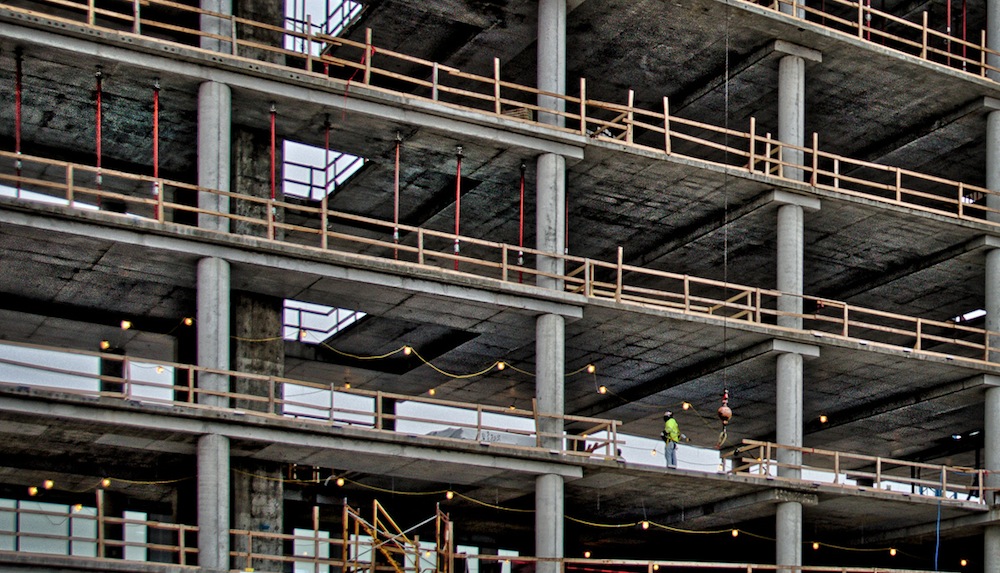Nonresidential construction spending dipped for a second consecutive month, falling 0.4% on a monthly basis in December, according to analysis of U.S. Census Bureau data released by Associated Builders and Contractors (ABC). Nonresidential construction spending totaled $681.2 billion on a seasonally adjusted, annualized basis. November's nonresidential construction spending estimate was revised lower by 0.6% to $683.7 billion.
For a second consecutive month, 12 of 16 nonresidential subsectors experienced spending decreases on a monthly basis. Private nonresidential spending dipped 2.1% for the month, while public sector spending expanded 2.2%.
"December's estimate is a bit unnerving not only because it represents a second consecutive month of spending decline, but also because unusually warm temperatures should have helped to translate into better spending performance," ABC Chief Economist Anirban Basu said. "A number of leading indicators suggest that nonresidential construction spending performance will remain choppy moving forward, both for the broader economy and the nation's nonresidential construction segment, including the Baltic Dry Index, the Conference Board's Index of Leading Economic Indicators and the Architecture Billings Index.
"This is not to suggest that the nonresidential recovery will end in the near term," Basu said. "Most firms continue to report healthy backlog and hiring remains aggressive, implying that many firms are staffing up in order to perform on forthcoming contractual opportunities. However, private credit is beginning to tighten and becoming more expensive. Consumer delinquencies are edging higher and corporate bond defaults have been climbing. Accordingly, many contractors may experience a slowdown in backlog accumulation in 2016, with the 2017-2018 economic outlook remaining decidedly murky."
Only four of 16 nonresidential construction sectors experienced spending increases in December on a monthly basis:
- Spending in the highway and street category expanded by 9.6% on a monthly basis and 11.7% on a yearly basis.
- Communication-related spending increased 4% month over month and 37.2% year over year.
- Sewage and waste disposal-related spending expanded 1.3% for the month, but fell 9.7% from the same time last year.
- Spending in the amusement and recreation category climbed 0.5% on a monthly basis and 9.2% on a year-over-year basis.
Spending in 12 of the nonresidential construction subsectors fell in December on a monthly basis:
- Spending in the power category fell 0.3% from November 2015, but is 7.6% higher than in December 2014.
- Commercial-related construction spending fell 0.6% for the month and 3.2% for the year.
- Educational-related construction spending fell 0.8% on a monthly basis, but expanded 10% on a yearly basis.
- Transportation-related spending fell 0.8% month over month, but expanded 2.3% year over year.
- Lodging-related spending was down 1.3% for the month, but is up 29.1% on a year-ago basis.
- Spending in the office category fell 1.8% from November 2015, but is up 16.6% from December 2014.
- Water supply-related spending fell 2.9% on a monthly basis and 6.6% on a yearly basis.
- Health care-related spending fell 3.2% month over month, but is up 0.4% year over year.
- Spending in the religious category fell 4.1% for the month and 1.7% for the year.
- Public safety-related spending declined 4.6% for the month and 7.4% for the year.
- Manufacturing-related spending fell 7.2% from November 2015, but is 19.6% higher than in December 2014.
- Conservation and development-related spending declined 9.9% on a monthly basis and is 8% lower on a yearly basis.
Related Stories
| Aug 11, 2010
USGBC honors Brad Pitt's Make It Right New Orleans as the ‘largest and greenest single-family community in the world’
U.S. Green Building Council President, CEO and Founding Chair Rick Fedrizzi today declared that the neighborhood being built by Make It Right New Orleans, the post-Katrina housing initiative launched by actor Brad Pitt, is the “largest and greenest community of single-family homes in the world” at the annual Clinton Global Initiative meeting in New York.
| Aug 11, 2010
AIA report estimates up to 270,000 construction industry jobs could be created if the American Clean Energy Security Act is passed
With the encouragement of Senate majority leader Harry Reid (D-NV), the American Institute of Architects (AIA) conducted a study to determine how many jobs in the design and construction industry could be created if the American Clean Energy Security Act (H.R. 2454; also known as the Waxman-Markey Bill) is enacted.
| Aug 11, 2010
Nation's first set of green building model codes and standards announced
The International Code Council (ICC), the American Society of Heating, Refrigerating and Air Conditioning Engineers (ASHRAE), the U.S. Green Building Council (USGBC), and the Illuminating Engineering Society of North America (IES) announce the launch of the International Green Construction Code (IGCC), representing the merger of two national efforts to develop adoptable and enforceable green building codes.
| Aug 11, 2010
More construction firms likely to perform stimulus-funded work in 2010 as funding expands beyond transportation programs
Stimulus funded infrastructure projects are saving and creating more direct construction jobs than initially estimated, according to a new analysis of federal data released today by the Associated General Contractors of America. The analysis also found that more contractors are likely to perform stimulus funded work this year as work starts on many of the non-transportation projects funded in the initial package.
| Aug 11, 2010
Broadway-style theater headed to Kentucky
One of Kentucky's largest performing arts venues should open in 2011—that's when construction is expected to wrap up on Eastern Kentucky University's Business & Technology Center for Performing Arts. The 93,000-sf Broadway-caliber theater will seat 2,000 audience members and have a 60×24-foot stage proscenium and a fly loft.
| Aug 11, 2010
Citizenship building in Texas targets LEED Silver
The Department of Homeland Security's new U.S. Citizenship and Immigration Services facility in Irving, Texas, was designed by 4240 Architecture and developed by JDL Castle Corporation. The focal point of the two-story, 56,000-sf building is the double-height, glass-walled Ceremony Room where new citizens take the oath.







